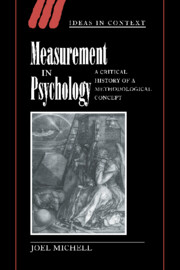Book contents
- Frontmatter
- Contents
- Preface
- Acknowledgments
- 1 Numerical data and the meaning of measurement
- 2 Quantitative psychology's intellectual inheritance
- 3 Quantity, number and measurement in science
- 4 Early psychology and the quantity objection
- 5 Making the representational theory of measurement
- 6 The status of psychophysical measurement
- 7 A definition made to measure
- 8 Quantitative psychology and the revolution in measurement theory
- Glossary
- List of references
- Index
- IDEAS IN CONTEXT
7 - A definition made to measure
Published online by Cambridge University Press: 22 September 2009
- Frontmatter
- Contents
- Preface
- Acknowledgments
- 1 Numerical data and the meaning of measurement
- 2 Quantitative psychology's intellectual inheritance
- 3 Quantity, number and measurement in science
- 4 Early psychology and the quantity objection
- 5 Making the representational theory of measurement
- 6 The status of psychophysical measurement
- 7 A definition made to measure
- 8 Quantitative psychology and the revolution in measurement theory
- Glossary
- List of references
- Index
- IDEAS IN CONTEXT
Summary
The number system is merely a model, to be used in whatever way we please.
(S. S. Stevens)Measurement is the business of pinning numbers on things.
(S. S. Stevens)The claim to be able to measure psychological attributes was thought to conflict with the Campbellian version of the quantity objection. Almost alone of his generation, Reese sought to defend the measurability thesis by a programme of empirical research. Instead of joining him, mainstream American quantitative psychologists responded in the tradition of Fechner: criticisms were deflected, not faced. Even Comrey's proposal that psychology's quantitative procedures be regarded simply as practical tools was unacceptable to those benefiting by the rhetoric of measurement. Deflecting the quantity objection required neutralising the representational theory's emphasis upon empirical tests of quantitative structure. Operationism provided the key. As a result of the recent revolutions in physics, operationism enjoyed considerable vogue within psychology, where it was interpreted by Stevens as a radical, liberating intellectual force. In Stevens' hands, it seemed to liberate modern psychology from the quantity objection.
Coming at a time of postwar expansion within the discipline, the Handbook of Experimental Psychology (1951), edited by Stevens, was very influential. Chapter 1, entitled ‘Mathematics, Measurement, and Psychophysics’, was written by him. It was the most complete exposition of his theory of measurement.
- Type
- Chapter
- Information
- Measurement in PsychologyA Critical History of a Methodological Concept, pp. 162 - 190Publisher: Cambridge University PressPrint publication year: 1999

